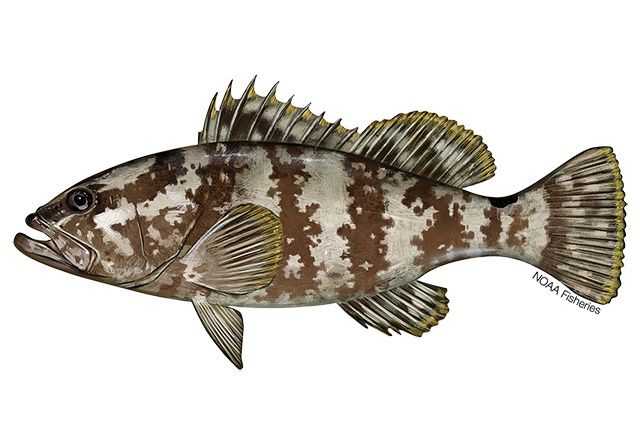Nassau Grouper

Species Details
Epinephelus Striatus
Serranidae
Perciformes
Nearshore, Offshore, Shallow Reef
30 - 55 lbs.
28" - 48"
Nassau Grouper (Epinephelus striatus) Fish Description
The Nassau Grouper (Epinephalus Striatus) is a popular target for both commercial and sport fishing enthusiasts. It can be easily distinguished from other groupers through its mostly reddish brown color; the dark uneven vertical bars that run across its body; and the uneven white specks scattered all over its entire body—from the head to the tail. Its coloration however changes during spawning season as the males change to black except for the white belly. The females, on the other hand, change their color to mostly black. They also tend to change color when they encounter threats, including other Nassau Groupers.
Nassau Groupers are also known to be solitary predators for most of their life, except when they gather during spawning season. They tend to stay near or within reefs, wrecks, and other underwater structures to either ambush prey or to seek protection from their predators. They are also more aggressive at night when they usually hunt for food and are said to be mostly inactive during the day. They have a unique way of devouring their food as they are known to suck in their prey whole to their wide gaping mouth. Their food mainly consists of small crustaceans including crabs and lobsters; although they are also known to eat a variety of marine animals such as smaller fishes and even snails and slugs.
Because of their size and their rather protective choice of habitat, the Nassau Grouper doesn’t have that many predators. Except for the occasional shark or barracuda that may sometimes wander into their turf, the only predators they mostly have problems with are humans. In fact, due to overfishing, the Nassau Grouper is now on the brink of extinction as the species is now classified as critically endangered. This is why the species population is currently under the supervision of authorities. And though fishing for Nassau Grouper is still allowed for recreational fishers in some parts of the US, it’s only allowed during spawning seasons, which happen in December and January, often during the full moon. Aside from the very limited fishing season, size and catch limitations were put into place to help with fish population recovery. Commercial fishing and harvesting of the species, on the other hand, is now totally banned.
Interesting Facts About Nassau Groupers
- Nassau groupers are among the biggest fish on the reef.
- They can grow as much as four feet long and can weigh up to fifty five pounds.
- There were records of Nassau Groupers reaching up to thirty years of age.
- They are protogynous hermaphrodites or they are all born females with many changing to male as they hit their sexual maturity.
- Spawning often starts on the full moon of December or January.
- They swallow their prey whole by sucking in water to their big gaping mouth by dilating the gill covers.
- They are mostly solitary except during spawning seasons when they gather in large congregations in certain areas in the reefs.
- They were once very common in our reefs, particularly from the coasts of the Carolinas down to the Gulf of Mexico.
- They are now classified as critically endangered due to overfishing as well as the widespread destruction of their natural habitats.
- They are also once very abundant in the Caribbean Sea and the West Indies but are now also endangered—again, due to overfishing.
- It’s named after the city of Nassau in the Bahamas as the fish is once plentiful around the city’s coastal waters.
- Except for occasional sharks, barracudas, and humans, the Nassau Grouper does not have many predators.
- Their colors and patterns help camouflage them, making them practically “invisible” in their natural habitat.
Nassau Grouper Size and Swimming Speed
Average sizes of the Nassau Grouper tend to be between one to two feet in length and weighs between ten to twenty pounds. Nassau groupers are also known to be one of the biggest reef fishes and, oftentimes, swim rather slowly as compared to other groupers.
Nassau Grouper Habitat and Distribution
The Nassau Grouper is a popular saltwater gamefish endemic in the coastal waters of the Atlantic Ocean—from the Carolinas in the US to the waters of southern Brazil. This fish may also be found from time to time within the waters of the Gulf of Mexico as well as around the Keys and the Yucatan Peninsula.
Although some may wander as deep as one hundred feet, most usually stay in the shallower parts of the water, typically within fifteen to eighty feet in depth. During the day, they are often inactive and can be seen just resting close to the bottom within rocks, reefs, and other marine structures. You may also find them in seagrass beds and mangrove habitats.
Nassau Grouper Fishing Tips
Nassau Groupers may not be known for their speed, but they can still be hard to land because of their sheer strength and girth. For a fish of this size and power, you will need a strong rod that could withstand a power of about 150 to 300 g. Because they are mostly found near or on the bottom, you will also need a good fishing weight as well as a long and strong braided line and reel. They usually bite quite easily and relatively faster than other reef fishes using just about any bait you have. But if you want to be sure, stick to live baits to attract this fish more with the movement of your bait.







